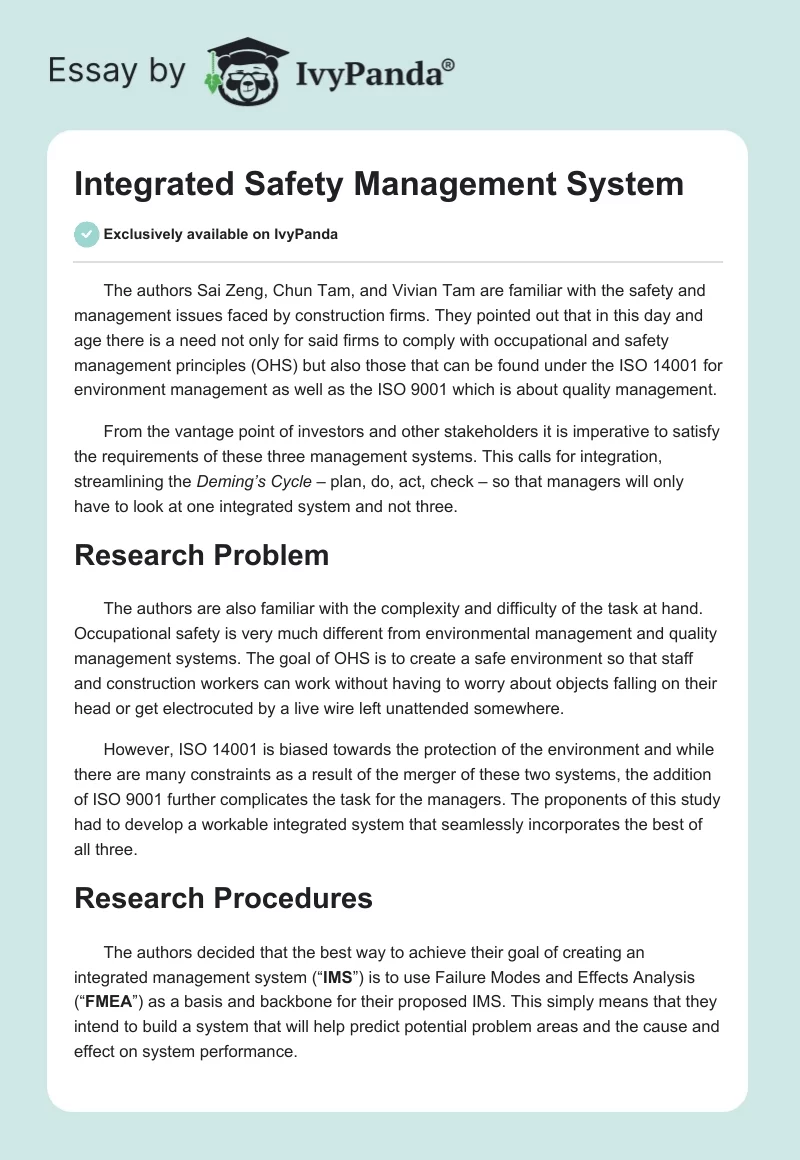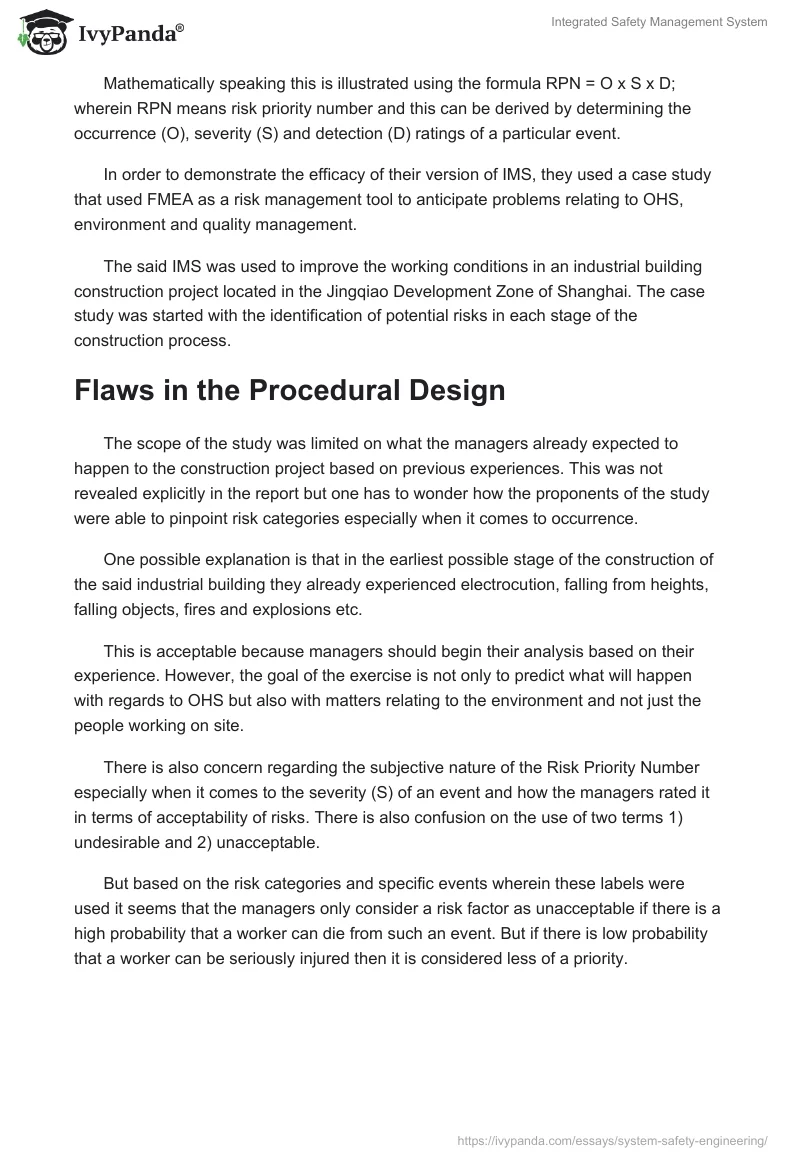The authors Sai Zeng, Chun Tam, and Vivian Tam are familiar with the safety and management issues faced by construction firms. They pointed out that in this day and age there is a need not only for said firms to comply with occupational and safety management principles (OHS) but also those that can be found under the ISO 14001 for environment management as well as the ISO 9001 which is about quality management.
From the vantage point of investors and other stakeholders it is imperative to satisfy the requirements of these three management systems. This calls for integration, streamlining the Deming’s Cycle – plan, do, act, check – so that managers will only have to look at one integrated system and not three.
Research Problem
The authors are also familiar with the complexity and difficulty of the task at hand. Occupational safety is very much different from environmental management and quality management systems. The goal of OHS is to create a safe environment so that staff and construction workers can work without having to worry about objects falling on their head or get electrocuted by a live wire left unattended somewhere.
However, ISO 14001 is biased towards the protection of the environment and while there are many constraints as a result of the merger of these two systems, the addition of ISO 9001 further complicates the task for the managers. The proponents of this study had to develop a workable integrated system that seamlessly incorporates the best of all three.
Research Procedures
The authors decided that the best way to achieve their goal of creating an integrated management system (“IMS”) is to use Failure Modes and Effects Analysis (“FMEA”) as a basis and backbone for their proposed IMS. This simply means that they intend to build a system that will help predict potential problem areas and the cause and effect on system performance.
Mathematically speaking this is illustrated using the formula RPN = O x S x D; wherein RPN means risk priority number and this can be derived by determining the occurrence (O), severity (S) and detection (D) ratings of a particular event.
In order to demonstrate the efficacy of their version of IMS, they used a case study that used FMEA as a risk management tool to anticipate problems relating to OHS, environment and quality management.
The said IMS was used to improve the working conditions in an industrial building construction project located in the Jingqiao Development Zone of Shanghai. The case study was started with the identification of potential risks in each stage of the construction process.
Flaws in the Procedural Design
The scope of the study was limited on what the managers already expected to happen to the construction project based on previous experiences. This was not revealed explicitly in the report but one has to wonder how the proponents of the study were able to pinpoint risk categories especially when it comes to occurrence.
One possible explanation is that in the earliest possible stage of the construction of the said industrial building they already experienced electrocution, falling from heights, falling objects, fires and explosions etc.
This is acceptable because managers should begin their analysis based on their experience. However, the goal of the exercise is not only to predict what will happen with regards to OHS but also with matters relating to the environment and not just the people working on site.
There is also concern regarding the subjective nature of the Risk Priority Number especially when it comes to the severity (S) of an event and how the managers rated it in terms of acceptability of risks. There is also confusion on the use of two terms 1) undesirable and 2) unacceptable.
But based on the risk categories and specific events wherein these labels were used it seems that the managers only consider a risk factor as unacceptable if there is a high probability that a worker can die from such an event. But if there is low probability that a worker can be seriously injured then it is considered less of a priority.
Analysis of Data
Take for example the difference when it comes to classification and management of toxic wastes and suffocation versus roof related falls. The former was considered moderate and the latter was considered as unacceptable.
This can be explained by the low occurrence of toxic wastes and suffocation but if one will look closely there is actually not much difference in occurrence compared to roof related falls. The real reason why it scored high on the list is the severity factor and again it has something to do with how an event can severely injure a construction worker.
Conclusion
The proponents of this study attempted to create an integrated management system using FMEA as the backbone for the said IMS. However, they were unable to demonstrate that it is possible using the procedures used in the said study.
There was a bias when it comes to OHS and less importance was given to environmental protection. Furthermore, it was not made clear how they were able to anticipate the environmental impact of the construction project.
The managers were focused on keeping their workers safe and to ensure that the project will continue without incident.
They scored high when it comes to integrating OHS safety concerns and how to increase the quality of the product by minimizing the risk on personnel but it is doubtful if the same effort was expended and the same resources were allocated to protect the environment. It is suggested that they use a different system to deal with environmental issues.
References
Stephans, R. (2004). System Safety for the 21st Century. New Jersey: John Wiley & Sons, Inc.
Zeng, S., C. Tam, & V. Tam. (2010). Integrating Safety, Environmental and Quality Risks for Project Management Using a FMEA Method. 21(1): pp. 44-52.


